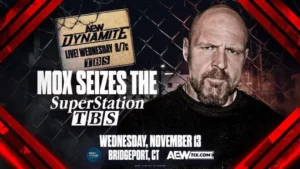Kevin Owens shocked the WWE Universe with a rare and dangerous piledriver on Randy Orton, bringing fans back to a time when moves like this held real weight. In an era of high-frequency finishers, Owens’ piledriver not only violated WWE’s ban but also tapped into the fear and excitement that made wrestling moves feel genuinely impactful.
In today’s wrestling, moves are so prevalent that finishers rarely deliver the same impact they once did. Take the superkick, for instance. In the ’90s and early 2000s, a single superkick could end a match, but wrestlers like the Young Bucks now use it multiple times.
Similarly, the Canadian Destroyer, used sparingly and as a finisher by Petey Williams, is now a routine move for wrestlers like Rey Fenix and Andrade, diminishing its novelty and impact. This shift reflects wrestling’s natural evolution and the increasing skill level of its athletes. With more advanced training methods and many wrestling schools, moves that once wowed audiences have become commonplace.
In the ’80s and ’90s, Jake “The Snake” Roberts’ DDT was devastating, so much so that fans clamored to see him use it against Hulk Hogan, the top babyface in wrestling then. Today, even a Tornado DDT can’t guarantee a two-count, so it’s pretty safe to say that times change, and fans’ expectations must move along with them.
With moves getting oversaturated every day and new moves being invented that raise the bar for a WTF moment in wrestling all the time, it is refreshing to see a maneuver that feels important and not watered-down. That is precisely what happened on the November 8, 2024 edition of SmackDown. Let’s set the stage a bit before we get to the moment.
Randy Orton vs. Kevin Owens: Pure Hatred
Since Bad Blood, when Kevin Owens attacked Cody Rhodes after the event, Owens has pursued Rhodes relentlessly, even targeting Rhodes’ mentor and his own friend, Randy Orton. Caught between the two due to being a friend of both, Orton has suffered attacks from Owens both in and out of the ring.
Recently, Orton requested that Triple H lift Owens’ suspension, demanding a match at Crown Jewel. After Orton provocatively suggested he was “protecting” Owens, Triple H agreed, setting up the match but absolving himself of responsibility for whatever Orton would do to him.
This match did not make it past entrances, as the bell did not ring that night in Riyadh. Instead, Owens and Orton brawled all around the arena, and Owens polished off Orton by sending him through a table with an elbow drop off a guardrail. However, Owens wasn’t satisfied as, before the show, he had stated that he wanted to put Orton down for good, and Orton was still breathing after Crown Jewel.
This led to the aforementioned SmackDown following Crown Jewel. With a hoarse voice following the recent brawl, Orton angrily demanded Owens come out to the ring, which inevitably led to another brawl. During this brawl and the scuffle with referees and ring personnel, Kevin Owens delivered a piledriver to Randy Orton, a move that has been banned in the larger WWE stratosphere since 2000.
Following this piledriver, Orton was stretchered out of the arena and carted towards an ambulance, all while moaning in pain with Cody Rhodes right by his side. The tone in the arena changed from a chaotic frenzy to stunned silence and shock, as even Michael Cole and Corey Graves sounded like they were on the verge of tears watching Orton get carried out of the arena. Eventually, it was revealed that Orton would be out indefinitely due to cervical cord neurapraxia, which is a temporary cessation of spinal cord function after direct impact to the cervical spinal cord.
BREAKING: After last night's brutal attack by @FightOwensFight on #SmackDown, @RandyOrton has been diagnosed with a cervical cord neurapraxia. There is no timetable for his return. pic.twitter.com/6VhQQyTxpm
— WWE (@WWE) November 9, 2024
WWE’s Piledriver Ban and Randy Orton’s Injury History
Professional wrestling is a highly dangerous endeavor, requiring complete coordination to ensure safety. Even minor mistakes in executing the simplest moves can lead to severe consequences. Atop that list is a move that has had such significant consequences in its history of being used that it has been banned from the top wrestling company in the world.
For decades, the piledriver has been seen as one of the most dangerous moves in wrestling. After all, the move involves a wrestler turning their opponent upside down and dropping them into a seated or kneeling position, driving their opponent head-first into the ground. The margin for error is slim to none, and a poorly executed piledriver can take years off one’s career.
One of the most infamous piledriver incidents occurred during 1997’s SummerSlam when Owen Hart accidentally drove Steve Austin’s head into the mat with a sit-out Tombstone Piledriver. Due to Austin being taller than Hart, he couldn’t position himself safely, resulting in a severe neck compression that temporarily paralyzed him. While Austin completed the match, defeating Hart, the injury was career-altering.
Despite a brief two-month recovery, Austin’s demanding schedule prevented proper healing, leading to chronic neck issues. Even after neck fusion surgery in 1999, his injury ultimately forced him into retirement by 2003, as continuing to wrestle could have caused permanent disability.
In response to incidents like Steve Austin’s injury, WWE (then-WWF) banned the piledriver in 2000, allowing its use only with special permission. Due to their height and ability to perform a safer, kneeling version, only The Undertaker and Kane were authorized to use the move.
Other wrestling promotions also enforce piledriver bans; in Tennessee, it’s grounds for immediate disqualification. In the UK, performers may even be fined for using it.
The only traditional piledriver used on WWE screens from 2000 until Owens’ incident last Friday was on the February 25, 2013 episode of Monday Night Raw during a match between CM Punk and John Cena. As expected, this move was met with surprise and amazement from Michael Cole and Jerry Lawler and is, to this day, considered one of the most shocking moments in recent WWE history.
That time CM Punk gave John Cena a piledriver on a random episode of RAW.
Triple H should get the move unbanned because the pop it will get the first time it gets used will be electric. pic.twitter.com/MQ1SkD7BIS
— Alastair McKenzie🏴 (@mckenzieas93V2) September 17, 2022
You may notice that the reaction to Punk’s piledriver on Cena was much milder than the reaction to Owens performing an admittedly worse-looking variation of the move on Orton, largely due to Orton’s long history of injuries. Since his 2002 debut, Orton has endured multiple injuries to his shoulders, back, and neck.
Shortly after debuting, he suffered a shoulder injury that sidelined him until 2003. In 2008, he broke his collarbone and missed four months. He herniated a disc in 2011, and in 2012, he injured his back after being thrown down a flight of stairs during a match.
That year, he also dislocated his shoulder, re-injured it in 2015, and missed nine weeks. At SummerSlam 2016, Orton sustained a concussion after being busted open against Brock Lesnar.
Most recently, Orton suffered a severe back injury in May 2022, leading to an 18-month absence. Despite doctors advising against him returning, Orton returned at Survivor Series 2023 and has continued wrestling since.
As you can see, Randy Orton has been quite banged up throughout his career, and a piledriver is probably the last thing he needs. Because of this, when Owens nailed the piledriver on Orton last Friday, the reaction quickly turned from shock and awe to horror and uncertainty.
Owens was immediately pulled apart from Orton and left the vicinity. At the same time, a stretcher was called to the ring to wheel Orton into an ambulance, with Corey Graves even questioning why a replay of the move was being shown.
It is worth noting that Graves, as a heel announcer, usually sides with the heels but has not shown much sympathy to Owens because even he believes that Owens took things too far.
Why This Matters
As stated before, a move in wrestling rarely leaves you in enough shock and awe that you find it hard to focus on the rest of the show. In promotions such as All Elite Wrestling and Pro Wrestling Guerilla, piledrivers are far more common than they are in WWE, and there’s a good chance you will see a Canadian Destroyer at least once every show.
This is not the case in WWE, as high-octane maneuvers are typically saved as match-enders or not used at all. However, even WWE is not immune to busting out an OMG moment for the fun of it. A few months ago, at WWE’s Backlash event during a Universal Championship match between Cody Rhodes and AJ Styles, Styles busted out the infamous Burning Hammer on Rhodes, which Rhodes kicked out of.
The original version of the Burning Hammer, used by Kenta Kobashi, was only used seven times and was never kicked out of, which caused a bit of an uproar on social media when Rhodes kicked out of Styles’ version.
AJ with a Burning Hammer!! #WWEBacklash pic.twitter.com/OWfUN8noua
— 𝐃𝐫𝐚𝐕𝐞𝐧 (@WrestlingCovers) May 4, 2024
Additionally, the novelty of the move, combined with Orton’s history of head, shoulder, and back injuries, made the moment feel all the more memorable compared to Punk busting out the move against Cena 11 years ago.
Michael Cole’s call of, “KEVIN OWENS WITH A PILEDRIVER TO RANDY ORTON, WHO WAS OUT FOR 18 MONTHS WITH A SERIOUS BACK INJURY. NEVER THOUGHT HE’D WRESTLE AGAIN, AND NOW THIS SICKO, THIS LUNATIC, KEVIN OWENS JUST DELIVERED A PILEDRIVER TO RANDY ORTON,” spelled out the significance of the situation to any fan who wasn’t given context beforehand.
In the current oversaturated landscape of professional wrestling, it feels nice to suspend your belief for once and go back to the old days when angles were built around moves potentially injuring wrestlers for real.
More From LWOS Pro Wrestling
Header photo – WWE – Stay tuned to the Last Word on Pro Wrestling for more on this and other stories from around the world of wrestling, as they develop. You can always count on LWOPW to be on top of the major news in the wrestling world, as well as to provide you with analysis, previews, videos, interviews, and editorials on the wrestling world. You can check out an almost unlimited array of WWE content on the WWE Network and Peacock.






